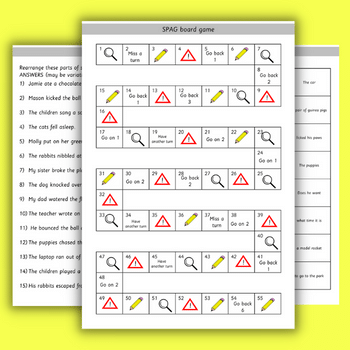This low-stakes grammar game helps children build better sentences

Christine Chen and Lindsay Pickton explain how this low-stakes analogue grammar game can sharpens pupils’ minds and leads to greater engagement…

- by Teachwire
- Classroom expertise and free resources for teachers

Philip Pullman once wrote of an “attitude … towards language” engendered when adults give time to sharing picture books with children, whereby “you trust it and find it exciting and full of possibilities and fun, something to play with and speculate with and take risks with and delight in.”
We wholeheartedly agree with Mr Pullman’s views on taking time over delicious picture books and want this feeling for language for all children; it inspires much of our work with schools.
One way of enhancing this attitude – particularly but not exclusively for the growing number of children who don’t have adult support like this at home – is through word games: low-stakes ways of trying out new vocabulary and grammatical structures, testing them for impact on meaning and delighting in outcomes.
Physical manipulation
A form of grammar and vocabulary play that encourages language manipulation in a very literal sense is the ‘human sentence’: a strip of paper onto which a main clause has been written, held at the front of the class by children, to which further words, phrases and clauses may be added (plus appropriate punctuation, of course).
This practice was commonplace around 15 years ago, but when we model it now, colleagues tend to have never seen the strategy, or they remark, “Don’t know why we stopped doing that!”
And we really shouldn’t have. In our experience, the physical manipulation of sentences in this way leads to greater engagement, and better application in writing, than digital alternatives.
Even when children come to the front to move parts of sentences on an interactive board, it just doesn’t seem to have the same impact. And compared to written grammatical exercises? Well, there is no comparison.
The strategy takes a bit of in-class training, naturally. Children need to hold the paper strips fairly steadily, and they need to be ready to join the sentence with their suggestions promptly; they need to write clearly on mini whiteboards (until they can, you’ll have to do this – see ‘tips for success).
And we find that these sessions run best when the class is clustered on the carpet, as it takes less time to swap and add children to the sentence at the front.
Meaning shifts
The crucial thing is that you take the time to explore the shifts in meaning that additions and swaps create. For example, imagine two sentence strips displaying a main clause each:
the Billy Goat tiptoed the Troll heard him
Note that there is no sentence demarcation as this fixes the sentence. The children must now try out different coordinating conjunctions (‘and’, ‘but’, ‘so’) to join the two clauses, and you can lead the discussion on the impact of each.
You might then extend this by looking at the use of subordinating conjunctions like ‘because’, ‘when’, and ‘although’: where would each of these work best for the meaning we’re trying to achieve?
Similarly, the arrangement of adverbials around a main clause may be examined for emphasis and even ambiguity:
the wolf huffed and puffed (main clause) in front of the door (adverbial for where) while the piggies cowered (adverbial for when)
From this, we can arrange:
While the piggies cowered, the wolf huffed and puffed in front of the door.
And:
While the piggies cowered in front of the door, the wolf huffed and puffed.
Now explore the impact of a comma after ‘cowered’ in that second sentence. Note also that the teaching of punctuation here is integral to the teaching of grammar and the teaching of meaning-making.
Children can be creative in their options within the focus grammatical area, but we’d recommend sticking to that grammatical focus. The extent to which this sharpens the mind and develops creative thinking can take your breath away.
Once, when asked for an adverbial to express ‘when’ as part of a ghost story, a child offered, “when they were least expecting it”!
Gimmick-free games
Why does holding bits of paper, moving positions, remembering to put punctuation marks in and arguing about the merits of a different word order seem to work so well in terms of memory and application?
It’s multi-sensory, of course, but not in a gimmicky, distracting way: everything is purposeful, and every addition and change must be considered for impact on meaning and context.
And it’s really, truly collaborative: lots of minds focused on the impact of a single sentence, irrespective of individual ‘writing ability’.
So why did so many of us stop using this strategy? Observationally, it seemed to disappear when interactive whiteboards reached ubiquity, around 2006.
But we also wonder if it never received the promotion that more commercially-packageable grammar strategies have had. Human sentences, after all, require only big bits of paper, pens, good classroom management and sound grammatical knowledge.
Tips for success
Select the grammar to be taught Things that work well with this technique include clause structure (and using conjunctions to join them); adding relative clauses; adding and trying phrases in different positions (particularly how-when-where adverbials and avoiding ambiguity); adding adjectives and/or changing modal verbs. Human sentences lend themselves less well to changing tenses and exploring the passive.
Be clear about the grammatical feature you’re teaching And almost always stick to it. Allow children to try different devices in the sentence only once they have secured their understanding of clause structure and your main teaching point.
Have strips of paper ever-ready A pile of them makes lesson prep quicker and easier – and they’ll be there if you want to lead an impromptu session to explore a usage or address a misconception. One sheet of flip-chart paper with three vertical slices produces four perfect sentence strips.
Always start a session with a simple sentence This reinforces the all-important sense-of-a-sentence and teaches children to start from a main clause and then make additions in their own writing.
Never use a capital or full stop on starting-point sentences This fixes the sentence and means nothing can be added at either end. Instead, have the children holding the strips use a simple physical (and moveable) reminder, eg a fist for stop; a hand-on-head (a “cap”) for a capital (note that this will require two children to hold even a short sentence). Other punctuation marks may be devised with appropriate hand positions!
Planning to ‘drop in’ a word, phrase or clause? Pre-doctor the sentence strip so that it may easily be split at the crucial part. Score it ready for tearing or cut it and lightly affix the pieces with small bits of tape.
Mini whiteboards are perfect for adding words and phrases Model what you want so that children don’t write too small, don’t rewrite the whole sentence and don’t capitalise or use full stops to demarcate. In classes where children are not yet ready to use mini whiteboards themselves, take oral suggestions and write them on boards yourself.
Keep circulating the children Many will enjoy being at the front of the room, holding the strips and mini whiteboards, but when they are there they don’t get to see the evolving sentence.
If working with a small group, use smaller paper strips Move them around on the table, devising other movable markers for punctuation. Children can still contribute their own words and phrases. Use extra small whiteboards or small blank paper strips.
Christine Chen and Lindsay Pickton are primary education advisers (primaryeducationadvisers.co.uk) supporting English development nationally.
Discover more ideas for punctuation games here.










